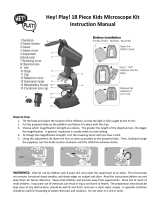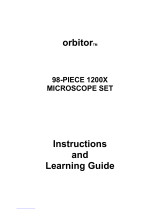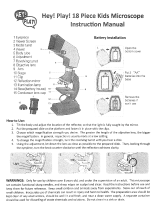Page is loading ...

Microscope Kit
#6805
Instructions
and
Learning Guide

How to use your new microscope:
There’s a whole tiny universe around you ready to
be explored! With the iOptron #6805 microscope kit
you can see millions of tiny living organisms in
amazing detail.
Your microscope set contains the following parts.
Check your microscope kit and make sure that you
have all of the parts listed below.
1 die-cast microscope (a)
1 scalpel (b)
1 spatula (c)
1 tweezers (d)
4 collecting vials (e)
1 test tube with cap (f)
1 petri dish (g)
1 pipette (h)
5 prepared slides (i)
18 blank slides (j)
18 slide labels (k)
36 slide covers (l)
2 small specimen vials (m1), (m2)
1 stirring rod (n)
1 magnifying glass (o)
1 measuring graduate (p)
1 spare light bulb (q)
l
b
c
d
e
f
g
h
i
j
k
a
n
o
p
q
m1
m2

Part Descriptions:
a) Die-cast metal microscope – The microscope
holds small items, called samples, to be studied
on clear slides. It shines a bright light from its
mirror or bulb through the small sample, and
then lenses make the sample look very big. This
microscope can make things look 300 times,
600 times, or even 1,200 times bigger than you
can see them with your own eyes.
b) Scalpel – A scalpel is a sharp blade that is used
to cut very thin pieces of material so you can
look at them with your microscope.
c) Spatula – The spatula has a large flat blade, but
it is not as sharp as the scalpel. It is used for
scraping off bits of material for testing and to
push down on soft samples to mash them flat.
d) Tweezers – The tweezers are like little pinchers.
They are used to pick up small samples and to
handle samples that you don’t want to touch with
your hands – like slimy mold!
e) Collecting vials – These are little plastic bottles
with tight-fitting lids. They are used to carry your
samples from the place you collected them to
the place you have your microscope set up.
f) Test tube with cap – This thin, clear tube is
used to hold liquid samples when you want to
see if anything is happening, like when a sample
changes color.
g) Petri dish – This is a round, flat dish with a clear
cover. It is used to grow and observe samples
such as molds.
h) Pipette – This is a soft plastic tube with a
squeeze bulb on one end that you use to
transfer a drop or two of liquid to a slide for
examination.
i) Prepared slides – These are slides with
professionally prepared samples on them for
you to examine.
j) Blank slides – These are clear slides for you to
use in preparing your own subjects for
examination.
k) Slide labels – These are little pieces of paper
with sticky backs. You can stick them on your
slides and record information, such as the name
of the sample, or when the sample was
prepared.
l) Slide covers – These are little circles or squares
made of thin, clear plastic. They are used to
cover very small samples on a slide. When they
are clean and dry they stick to the glass slide
with a static electricity charge.
m) Small specimen vials – These small containers
are for collecting and storing small quantities of
liquid samples for later study.
n) Stirring rod – Use this rod to mix liquids until
they are well blended. An example is when you
mix salt in water.
o) Magnifying glass – This is useful for taking a
close look at a sample before you examine it
under the high-power magnification of your
microscope.
p) Measuring graduate – This plastic cup is
marked with measuring lines so that you can
accurately measure quantities of liquids in your
experiments.
q) Spare light bulb – This spare bulb will replace
the one in the illuminator lamp when it eventually
wears out.

Parts of Your Microscope:
A. Eyepiece – The eyepiece is where you look into
the microscope. It is a small magnifying lens that
collects the image projected by the objective lens.
B. Body tube – This is the main tube of the
microscope. The image from the sample on the
slide travels up this tube to the eyepiece.
C. Focusing knobs – Turn these knobs very
slowly to bring the image of your sample into focus
so you can see it sharply.
D. Revolving lens turret – The turret holds the
three objective lenses. To change the lenses, rotate
the turret slowly until each lens clicks into position.
E. Objective lenses – These lenses give three
different magnifying powers when working with the
eyepiece lens. They make samples look 300 times
(300X), 600 times (600X) or 1,200 times (1,200X)
bigger than you can see them with your eyes alone.
F. Arm – This curved piece is the “backbone” of the
microscope and holds everything together. You can
tilt and adjust the angle of this arm to set the most
comfortable viewing position.
G. Stage – The stage is the flat platform that
supports your slides for viewing.
H. Slide clips – The two clips on the stage hold
your slide in position so that it doesn’t move around
while you are looking at it.
I. Mirror – The mirror aims light from a bright
source, like a window or a table lamp, upward
through the slide you are studying so you can see it
more clearly.
J. Electric illuminator – When there is not enough
light available for the mirror to fully illuminate your
slide, you can turn the mirror over and use the
bright electric illuminator bulb as your light source.
A. Eyepiece
B. Body tube
C. Focusing knob
D. Revolving lens turret
E. Objective lenses
F. Arm
G. Stage
H. Slide clip
I. Mirror
J. Electric illuminator (on
opposite side of mirror)
K. Base (battery compartment)
A
B
C
D
E
F
G
H
I
J
K

K. Base (battery compartment) – The base
provides a solid support for your microscope. It also
holds the batteries for the electric illuminator. See
the first section in ‘Getting Started’ for instructions
on installing and changing the batteries.
Helpful Hints
1) The most important parts of your microscope
are the lenses. Handle them with care. If the
lenses are dirty or dusty you can clean them
with a soft cotton cloth or a special lens-
cleaning tissue. Do not wipe them with a
finger or a regular facial tissue.
2) Always store your microscope in its
protective storage case.
Getting Started
1) You will need to insert two AA alkaline batteries
in the base of the microscope. First, you must
remove the rubber antiskid bottom cover to
access the battery compartment. You will need
to use a Phillips-head (+) screwdriver to remove
the two screws on this bottom cover. Once the
cover is removed, insert the batteries as shown,
making sure that the (+) and (-) terminals are
properly aligned. Replace the cover and re-
insert the screws. Do not overtighten.
2) Place the microscope on a flat surface near a
bright light or window. There is no need to
insert a slide just yet. Adjust the angle of the
mirror so that when you look into the eyepiece
you see a bright circle of light. Do not point the
mirror toward the sun as eye damage may
result. If there is no bright light available, or if
the room lighting is poor you can use the
microscope’s electric illuminator. To turn on the
illuminator flip the mirror over so that the light
bulb is aimed upward. The light will come on by
itself. Look through the eyepiece and adjust the
angle of the light until you see a bright circle.

3) Once you can see a bright circle of light in
the eyepiece your microscope is ready for
use.
4) Choose one of the prepared sample slides
from your set. Place it under the two spring
clips on top of the stage.
5) Next, choose the magnifying power you
want to use. Your microscope can provide
magnifying powers of 300X, 600X, and
1,200X. Remember that the longer objective
lenses provide the higher powers. Most
observing is done at low-power, and we
suggest that you start with the 300X setting.
6) To change the magnifying strength turn the
revolving lens turret until you hear a click.
7) Turn the focusing knob until the objective
lens is almost touching the slide. Don’t let
the lens touch the slide as you may break
the slide and damage the lens. Now look
through the eyepiece and slowly turn the
focusing knob back until you see the sample
clearly.
How to make your own prepared slides
Samples for examination should be very thin so
that light can pass through them. If the sample is
too thick it will appear dark in the microscope.
There are thousands of common items around the
house and in the yard that can provide interesting
samples. To name just a few you could start with
cloth fibers, hair, plant or vegetable leaves, grass,
paper, onion skin, pollen, dust, salt crystals, and
even water!
Making a Temporary Slide
A) Start with a clean blank slide. Clean slides
are important. If your slide is dusty or dirty,
you should clean it with a soft cloth, so that
you do not also magnify dirt or dust along
with the sample you want to view. This can
be distracting and even confusing!
B) Prepare a thin sample. You may have to
slice it with the scalpel. Always be very
careful. You should ask for adult help when
using sharp objects.
C) Pick up your sample with the tweezers and
put it on the center section of the slide. Add
one drop of water. To enhance viewing you
may add a drop of dye instead of water.
D) Gently place a slide cover over the sample,
being careful not to allow any air bubbles in.
E) Remove any excess water or dye with a
piece of paper towel by pressing it down
gently over the slide cover.
F) Now you can observe your slide.

History of the Microscope
During the late Middle Ages (around A.D. 1200 to
1450), the growing demand for eyeglasses led to
experimentation with lenses and making small
things appear larger. As a result of this
experimentation, the first microscope was created
(probably in Holland in the late 16th century—the
Dutch were masters at the craft of magnification).
The first microscopes were operated with only one
lens—then the compound microscope was invented
in the 1590s, which used two or more lenses to
magnify objects even more. Among the most
famous people to use a compound microscope was
Robert Hooke of England. During the 1600s, Hooke
observed and recorded the miniscule parts of
nature previously unexplored, such as the
intricacies of feathers, insects, and even mold.
Furthermore, Hooke introduced the concept of
cells—the smallest independently functioning part
of an organism.
Today scientists use microscopes to aid in the
world of medicine, help build better and stronger
materials for everyday use, and even discover
hidden mysteries about ancient cultures and
environments.
One of the most powerful scientific instruments is
called the scanning electron microscope (SEM).
Instead of magnifying objects using lenses, like
your microscope, the SEM focuses a beam of
invisible particles called electrons on the object,
and collects the electrons as they bounce back.
These electrons are then turned into a black-and-
white image on a television screen. SEMs can
magnify some small objects as many as 100,000
times—that’s about 50 times more powerful than
the strongest ordinary compound microscope.
Cells
One subject that’s easy to observe with your
microscope is a cell. Both plants and animals have
cells. Plant cells (which Robert Hooke identified)
have structured walls, and basically serve as mini–
food factories. Photosynthesis takes place inside
the plant cell. Photosynthesis is the conversion of
solar energy into chemical energy (or the
production of oxygen and glucose from water and
carbon dioxide).
Unlike plant cells, animal cells have a permeable
membrane (instead of rigid, structured walls). This
permeable membrane—through which certain
things can pass—encases a number of even
smaller specialized components called organelles.
An animal’s body (including yours) is entirely made
up of these cells. They range in size and shape,
depending on their function and location. Even the
cell’s life span varies from type to type—heart
muscle cells, cartilage cells (the soft tissue
connecting your bones at the joints), and most
neurons (brain cells) can never divide, regenerate,
or be replaced. On the other hand, liver cells are
replaced about every 500 days, cells in your
stomach lining about every two days, and skin cells
about every one to 34 days.
Check this out! Try taking a toothpick and gently
swiping the inside of your cheek. Then take those
cells you’ve gathered on the toothpick and make a
slide for your microscope. (See “How to make your
own prepared slides” on page 6.) What do you see
when you observe the slide under magnification?
Now look at the prepared slides included with your
microscope. Can you see the rigid walls that plant
cells are known for?
Frequently Asked Questions
1) What can I see with my microscope?
You can see thousands of things that are difficult or
impossible to see with your eyes. You can see tiny
plants and animals. You can observe plant and
animal cells. You can see the differences between
different plants, different papers, different fibers,
and hairs from different people. You can study
crystals, rocks, and minerals. The uses for your
microscope are practically endless.
2) What is meant by power?
Power is a measure of the seeing ability of your
microscope. It is really a short way of saying
“magnifying power.” Your microscope has three
powers. They are 300X (pronounced “300 times”),
600X, and 1,200X. This means that your
microscope can magnify the view of a sample so
that it appears 300 times, 600 times, or 1,200 times
larger than the way you see it with your own eyes.
3) I look through my microscope and all I see is
darkness. Why?

This could be because the mirror or light bulb is not
positioned properly to aim light up into your
microscope. Or maybe the sample you are looking
at is too thick so the light cannot shine through it.
4) All I can see is a partial circle of light. Why?
To see your sample properly, the light source must
be centered through the slide to provide the
brightest and most even illumination. Try gently
moving the mirror or light until you see a full, evenly
lit circle while looking through the microscope.
5) I have a very thin sample on my slide, but I
can’t see any detail.
First, make sure that the image is in sharp focus by
adjusting the focusing knobs. If the problem still
exists you should add a drop of red or blue stain to
the sample. Stains make hard-to-see objects like
plant cells stand out so they can be seen better.
BATTERY INFORMATION:
This unit uses two AA batteries. Always use fresh batteries. Do not use rechargeable batteries. If the microscope will not be used for a
long time, remove the batteries. Nonrechargeable batteries are not to be recharged. Different types of batteries or new and used
batteries are not to be mixed. Do not take batteries apart. Exhausted batteries are to be removed from the microscope. The supply
terminals should not be short-circuited. Do not dispose of batteries in fire. They may explode.
!
WARNING! CHOKING HAZARD –
Small parts. Not suitable for children
under 3 years.
For technical support call us at 1.781.569.0200 or email [email protected]
www.iOptron.com
/



